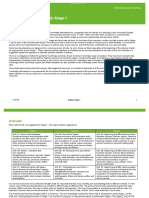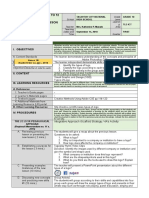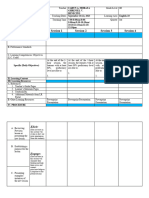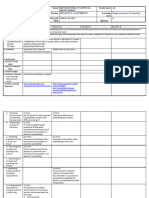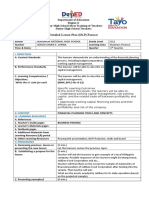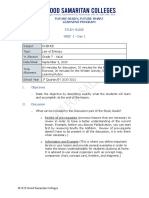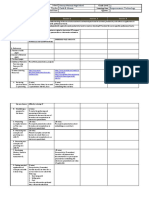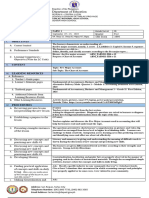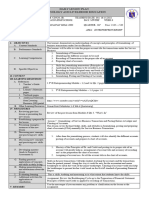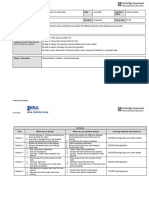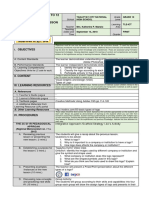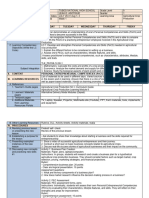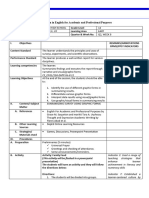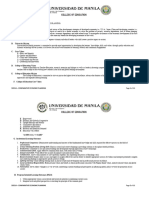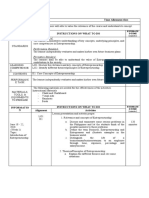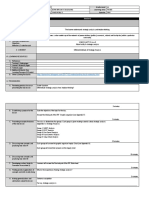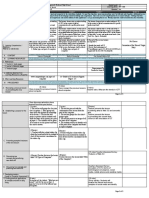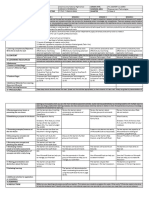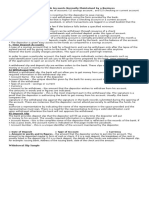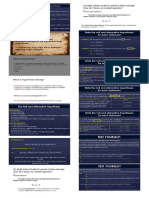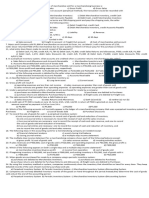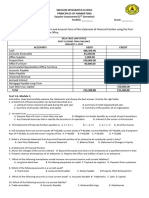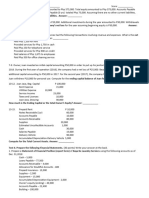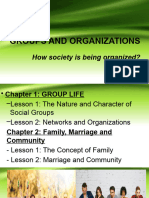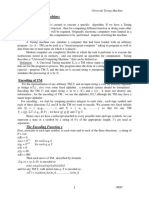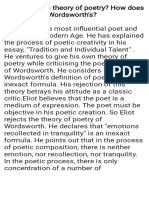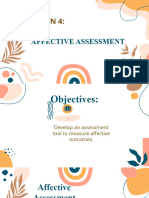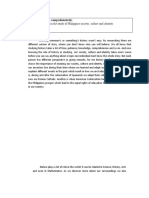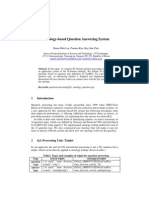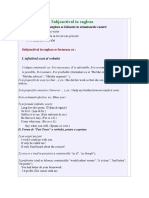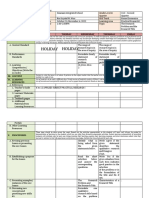ABM - FABM11 IIIa 3
ABM - FABM11 IIIa 3
Uploaded by
PHEGIEL HONCULADA MAGAMAYCopyright:
Available Formats
ABM - FABM11 IIIa 3
ABM - FABM11 IIIa 3
Uploaded by
PHEGIEL HONCULADA MAGAMAYOriginal Title
Copyright
Available Formats
Share this document
Did you find this document useful?
Is this content inappropriate?
Copyright:
Available Formats
ABM - FABM11 IIIa 3
ABM - FABM11 IIIa 3
Uploaded by
PHEGIEL HONCULADA MAGAMAYCopyright:
Available Formats
Instructional Planning
(The process of systematically planning, developing, evaluating and managing the instructional process by using
principles of teaching and learning - D.O. 42, s. 2016)
Detailed Lesson Plan (DLP) Format
School BUKIDNON NATIONAL HIGH SCHOOL Grade Level GRADE 11
Teacher SHELLAMAE S. BUTIHIN Learning Area FABM1
Time & Dates Quarter 3rd
I. OBJECTIVES
A. Content Standards At the end of the lesson, 85% of the learners should be able to demonstrate their
understanding of the definition, nature, function, and history of accounting.
B. Performance Standards The learners shall be able to cite specific examples in which accounting is used in
making decisions.
C. Learning Competencies / Explain the functions of accounting in business.
Objectives. ABM_FABM11-IIIa-3
Write the LC code for each
II. CONTENT Introduction of Accounting
III. LEARNING RESOURCES Laptop, PowerPoint, DLP/TV, video/pictures, sticks, meta cards, strips paper, manila
paper and pentel pen.
A. References Slideshare; Investopedia; Google
1. Teacher’s Guide pages TG’s pgs. 3
2. Learner’s Materials
pages
3. Textbook pages
4. Additional Materials
from Learning Resource
(LR) portal
B. Other Learning
Resources
V. PROCEDURES
A. Reviewing previous (5 minutes)
lesson or presenting the A short game called “Pick a Stick” will be done. Students will pick a stick, the one who
new lesson pick a stick with a word share, comment and like will say something about the
previous topic.
B. Establishing a purpose (2 minutes).
for the lesson The teacher will introduce the new topic to the class citing the objectives of their
lesson and the purpose of this lesson using the PowerPoint.
C. Presenting examples/ (8 minutes).
instances of the new The teacher will play a 3 minutes video clip or inspirational story showing the function
lesson of accounting.
D. Discussing new concepts
and practicing new skills #1 Then let student reflect on what they have seen and write it in a piece of paper and
ask someone to share in class. A short rationalization will be done.
E. Discussing new concepts (20 minutes)
and practicing new skills #2 Students will be grouped into 8 and let them portray a scenario or situation of daily
activities wherein accounting is needed or a situation wherein the function of
accounting is being shown in 2 minutes. This will be present in class.
As an Individual
Family
Career
F. Developing mastery
Business
(Leads to Formative
Investor
Assessment 3)
Creditor
G. Finding practical Government
applications of concepts Country
and skills in daily living Rubrics Score
G-1 G-2 G-3 G-4 G-5 G-6 G-7 G-8
Content (12)
Creativity (8)
Time-bound
(5)
TOTAL (25)
Process questions are given:
1. Based from the presentations given, how these information relevant as
accounting students?
2. In what instance accounting is very vital to ourselves, to our family, and to the
whole nation?
3. What if accounting is not discovered? How can you imagine our world would
be?
H. Making generalizations (15 minutes) Teachers and learner will have and interactive discussion (talking and
and abstractions about the asking question) to the learners about their learning to gain insights on their
lesson understanding and to progress and clarify their thinking.
1. What is the function of accounting? Why we need to learn the accounting
process?
2. How does it applies in our lives?
A short saying will be flashed on the screen for them to ponder.
“Even an accounting has a function, then what could be yours?
I. Evaluating learning Assessment
( 10 minutes)
Let the learners write a Haiku about the function of accounting in a piece of paper and
randomly pick somebody to share his/her output at least 5 and the rest will pass their
paper.
Rubric:
Content 10
Creativity 5
J. Additional activities for Read about origin of accounting.
application or remediation
V. REMARKS
VI. REFLECTION
A. No. of learners who
earned 80% on the
formative assessment.
B. No. of learners who
require additional activities
for remediation.
C. Did the remedial lessons
work? No. of learners who
have caught up with the
lesson.
D. No. of learners who
continue to require
remediation
E. Which of my teaching
strategies worked well?
Why did these work?
F. What difficulties did I
encounter which my
principal or supervisor can
help me solve?
G. What innovation or
localized materials did I
use/discover which I wish
to share with other
teachers?
You might also like
- DLL - 2nd Quarter SA AP 10Document5 pagesDLL - 2nd Quarter SA AP 10DenivieApina75% (8)
- English Stage 7 SOW Tcm143-354015Document56 pagesEnglish Stage 7 SOW Tcm143-354015Inna Glushkova100% (2)
- This Study Resource Was: I. ObjectivesDocument3 pagesThis Study Resource Was: I. ObjectivesFebbie Angela DazoNo ratings yet
- DLP Cot1 PhiloDocument3 pagesDLP Cot1 PhilojulzhaideNo ratings yet
- Lessonm Plan For COTDocument6 pagesLessonm Plan For COTGizellen Guibone100% (1)
- G2 DLP Applied Econ Chap2#5c 2Document5 pagesG2 DLP Applied Econ Chap2#5c 2Raffy Jade Salazar100% (1)
- KRA 1other SampleDocument43 pagesKRA 1other SampleLiza Mea Guhayon ReblincaNo ratings yet
- 1 DLL Format 2019 KPM MOVDocument3 pages1 DLL Format 2019 KPM MOVRebecca BillosilloNo ratings yet
- TEMPLATEDocument6 pagesTEMPLATECaryn MorataNo ratings yet
- 1stQ Week4.docx Version 1Document4 pages1stQ Week4.docx Version 1refuerzorinoNo ratings yet
- ABM - BF12 IIIc D 12Document3 pagesABM - BF12 IIIc D 12Raffy Jade Salazar0% (1)
- DLP Ict 8 Q1 M1Document5 pagesDLP Ict 8 Q1 M1Angelica ArroyoNo ratings yet
- DLL Ls6 Bin 1 Formatting and Inserting Graphics in A Document JhsDocument3 pagesDLL Ls6 Bin 1 Formatting and Inserting Graphics in A Document JhsJuvilla BatrinaNo ratings yet
- Study Guide WEEK 1 - Day 1: Future Ready, Future Smart Learning ProgramDocument4 pagesStudy Guide WEEK 1 - Day 1: Future Ready, Future Smart Learning ProgramRozel EncarnacionNo ratings yet
- Monday Tuesday Wednesday Thursday Friday: I. ObjectivesDocument2 pagesMonday Tuesday Wednesday Thursday Friday: I. ObjectivesReynald ManzanoNo ratings yet
- 7e's DLL - BANK RECONCILIATION For Observation 10-15-19Document2 pages7e's DLL - BANK RECONCILIATION For Observation 10-15-19Marilyn Nelmida Tamayo100% (1)
- Dll-Cot Math RatioDocument11 pagesDll-Cot Math RatioMarites JudiNo ratings yet
- Daily Lesson Log: School Grade Level Teacher Learning Area Teaching Dates and Time QuarterDocument4 pagesDaily Lesson Log: School Grade Level Teacher Learning Area Teaching Dates and Time QuartercecileNo ratings yet
- DLL in Mil 4.27.23Document4 pagesDLL in Mil 4.27.23Glenn PrestozaNo ratings yet
- RCD Daily-Lesson-Log-Fabm 1 Fifth WeekDocument3 pagesRCD Daily-Lesson-Log-Fabm 1 Fifth WeekRosanno DavidNo ratings yet
- 1qtrmodule7entrepdlpoct10 14,22Document3 pages1qtrmodule7entrepdlpoct10 14,22AlfredBCincoNo ratings yet
- Week 15 LC 14Document4 pagesWeek 15 LC 14Jemar AlipioNo ratings yet
- Judul Wahyu Purnomo PKLDocument16 pagesJudul Wahyu Purnomo PKLMonica HapsariNo ratings yet
- TLE - HEHS7/8PW-Oghj-9 Lesson 5: Participate in Workplace Communication (PW) LO1.Obtain and Convey Workplace InformationDocument4 pagesTLE - HEHS7/8PW-Oghj-9 Lesson 5: Participate in Workplace Communication (PW) LO1.Obtain and Convey Workplace Informationannalyn cabug-osNo ratings yet
- M11GM IIb 3Document4 pagesM11GM IIb 3Hordan Jay SalleNo ratings yet
- DLL Empowement Technologies - 1stQ Week4Document4 pagesDLL Empowement Technologies - 1stQ Week4Joelle M. Cruz100% (1)
- DLP Demo-Bank StatementDocument5 pagesDLP Demo-Bank StatementPhegiel Honculada MagamayNo ratings yet
- M11GM IIb 2Document3 pagesM11GM IIb 2Hordan Jay SalleNo ratings yet
- Daily Lesson Log: Grades 1 To 12Document6 pagesDaily Lesson Log: Grades 1 To 12KèlǐsītǎnKǎPángNo ratings yet
- LP Accounting Grade X Session 1Document5 pagesLP Accounting Grade X Session 1Andrew AriantoNo ratings yet
- 1 DLL Format 2019 KPM MOVDocument3 pages1 DLL Format 2019 KPM MOVRebecca BillosilloNo ratings yet
- 1 DLL Format 2019 KPM MOVDocument3 pages1 DLL Format 2019 KPM MOVRebecca BillosilloNo ratings yet
- ACP9-Q1-DLL-Week 1Document4 pagesACP9-Q1-DLL-Week 1Leah AsotigueNo ratings yet
- MATH G11 GM I Day 4Document3 pagesMATH G11 GM I Day 4AJ Diawara CusayNo ratings yet
- Detailed Mathematics Lesson Plan: Grade Level Quarter / Domain Week & Day No. Page NoDocument2 pagesDetailed Mathematics Lesson Plan: Grade Level Quarter / Domain Week & Day No. Page NoDanilo CumpioNo ratings yet
- DLL TemplateDocument3 pagesDLL TemplateLemuel Condes100% (1)
- Eapp Cot 2024Document7 pagesEapp Cot 2024Gracee UyNo ratings yet
- I ObjectivesDocument3 pagesI ObjectivesAlzen GalaponNo ratings yet
- EmpowermentDocument2 pagesEmpowermentPearl Arianne MontealegreNo ratings yet
- Comparative Economic Planning 1 SyllabusDocument11 pagesComparative Economic Planning 1 SyllabusRenzo GueribaNo ratings yet
- ABM - AOM11 Ie G 13Document7 pagesABM - AOM11 Ie G 13Jarven Saguin100% (1)
- Daily Lesson Log: School Teacher Teaching Dates and TimeDocument5 pagesDaily Lesson Log: School Teacher Teaching Dates and TimeNosaj TriumpsNo ratings yet
- Q2 W8 DLL EntrpDocument2 pagesQ2 W8 DLL EntrpAiralyn Valdez - MallaNo ratings yet
- UP - Entrep Final (2018)Document20 pagesUP - Entrep Final (2018)salome22No ratings yet
- PC Ii-14Document6 pagesPC Ii-14Fritzie Jane Babia BayotlangNo ratings yet
- Week 8 Q2 ETDocument3 pagesWeek 8 Q2 ETMarjoriekate EsquivelNo ratings yet
- Lesson 12Document8 pagesLesson 12Giselle Erasquin ClarNo ratings yet
- Gen Math I - 4Document3 pagesGen Math I - 4Gladzangel LoricabvNo ratings yet
- Trends Week 4 Days 1 4 One SessionDocument4 pagesTrends Week 4 Days 1 4 One SessionMichael KitNo ratings yet
- SHS DLL Week 1Document3 pagesSHS DLL Week 1Rd DavidNo ratings yet
- Science COT 2Document3 pagesScience COT 2Jenhrel MolateNo ratings yet
- Q2 - Module2 - Lesson 2 (COT - 1)Document3 pagesQ2 - Module2 - Lesson 2 (COT - 1)Leoncio QuientelaNo ratings yet
- SPEC - 121 - E - Unit 2 - TTH - 7 30-9 00AM - ODATO - IVYDocument5 pagesSPEC - 121 - E - Unit 2 - TTH - 7 30-9 00AM - ODATO - IVYIvy OdatoNo ratings yet
- 1.5 Workplace Protocol and InteractionDocument4 pages1.5 Workplace Protocol and InteractionFernando JoseNo ratings yet
- DAILY LESSON LOG OF M11GM-Ia-4 (Week One-Day Four)Document3 pagesDAILY LESSON LOG OF M11GM-Ia-4 (Week One-Day Four)Gladzangel LoricabvNo ratings yet
- RPP Akuntansi Dasar Dalam Bahasa InggrisDocument18 pagesRPP Akuntansi Dasar Dalam Bahasa InggrisMuhamad Jati PratomoNo ratings yet
- Science Lesson PlanDocument7 pagesScience Lesson PlanRomelyn Rebucas100% (2)
- CSS 9 - Qrtr1 WEEK 9Document2 pagesCSS 9 - Qrtr1 WEEK 9MELAIDA CASTANAR GARIBAYNo ratings yet
- I ObjectivesDocument3 pagesI Objectivesclyde begoniaNo ratings yet
- Fabm Bank Related TransactionDocument3 pagesFabm Bank Related TransactionPHEGIEL HONCULADA MAGAMAYNo ratings yet
- Elements of A Balance Sheet - Docx FINALDocument4 pagesElements of A Balance Sheet - Docx FINALPHEGIEL HONCULADA MAGAMAYNo ratings yet
- Traditional and Contemporary MarketingDocument28 pagesTraditional and Contemporary MarketingPHEGIEL HONCULADA MAGAMAYNo ratings yet
- Principles of Marketing Customer & C. RelationshipDocument22 pagesPrinciples of Marketing Customer & C. RelationshipPHEGIEL HONCULADA MAGAMAYNo ratings yet
- Hyphotesis TestingDocument1 pageHyphotesis TestingPHEGIEL HONCULADA MAGAMAYNo ratings yet
- Merchandising ReviewDocument2 pagesMerchandising ReviewPHEGIEL HONCULADA MAGAMAYNo ratings yet
- FABM2 Quarter AssessmentDocument2 pagesFABM2 Quarter AssessmentPHEGIEL HONCULADA MAGAMAYNo ratings yet
- Merchandise Problem PeriodicDocument7 pagesMerchandise Problem PeriodicPHEGIEL HONCULADA MAGAMAYNo ratings yet
- Abm 3s Problem SolvingDocument2 pagesAbm 3s Problem SolvingPHEGIEL HONCULADA MAGAMAYNo ratings yet
- Socio1 GROUPS AND ORGANIZATIONSDocument43 pagesSocio1 GROUPS AND ORGANIZATIONSPHEGIEL HONCULADA MAGAMAYNo ratings yet
- Presentation On Methods of Data CollectionDocument57 pagesPresentation On Methods of Data CollectionTHOUFEEKNo ratings yet
- Noise Bad PDFDocument17 pagesNoise Bad PDFGerson Rios LemeNo ratings yet
- Training - Modules - 20200831 - v1 CRS-RDocument6 pagesTraining - Modules - 20200831 - v1 CRS-RMaria CeciliaNo ratings yet
- Rogers1957 PDFDocument9 pagesRogers1957 PDFChaterine LimNo ratings yet
- David 5Document88 pagesDavid 5Bhumi GandhiNo ratings yet
- Parsci Header and FooterDocument2 pagesParsci Header and FooterMikaela SantosNo ratings yet
- Psychology Class 12 CH 1 - Variations in Psychological Attributes NCERT SolutionsDocument7 pagesPsychology Class 12 CH 1 - Variations in Psychological Attributes NCERT Solutionsmanyachauhan2709No ratings yet
- Universal Turing MachineDocument4 pagesUniversal Turing MachineFile StreamNo ratings yet
- Eliot Vs Wordsworth Poetic DictionDocument5 pagesEliot Vs Wordsworth Poetic DictionNuman KhanNo ratings yet
- Quiz Number 1 in Contemporary ArtsDocument1 pageQuiz Number 1 in Contemporary ArtsAngelica SalesNo ratings yet
- SentencesDocument3 pagesSentencesAsh G Asad MalikNo ratings yet
- Southeast Asian Institute of Educational Training, Inc.: Seamless Learning Readiness TestDocument2 pagesSoutheast Asian Institute of Educational Training, Inc.: Seamless Learning Readiness TestYlla Lourizze EamiguelNo ratings yet
- Assess 2 Lesson 4Document27 pagesAssess 2 Lesson 4sadsadako111No ratings yet
- What Role Does History Take in The Study of Philippine Society, Culture and IdentityDocument4 pagesWhat Role Does History Take in The Study of Philippine Society, Culture and IdentityAustere DameNo ratings yet
- Traditional and Alternative AssessmentDocument34 pagesTraditional and Alternative AssessmentCaro MoragaNo ratings yet
- Noun (Subject) + Verb + The + Superlative Adjective + Noun (Object)Document6 pagesNoun (Subject) + Verb + The + Superlative Adjective + Noun (Object)anaNo ratings yet
- Revised Uts Module 1.Document8 pagesRevised Uts Module 1.Ricky Jr. P. VILLANUEVANo ratings yet
- Managing Innovation and Fostering Corporate EntrepreneurshipDocument14 pagesManaging Innovation and Fostering Corporate Entrepreneurshiptantriwidyas100% (1)
- The Impact of School Facilities On The Learning Environment by Bert VandiverDocument1 pageThe Impact of School Facilities On The Learning Environment by Bert Vandiverintomr871104No ratings yet
- Critical Reasoning and Communication SkillsDocument195 pagesCritical Reasoning and Communication Skillsgpveetil83% (6)
- CL2013 Abstract Book PDFDocument375 pagesCL2013 Abstract Book PDFabdulhadiNo ratings yet
- Ontology-Based Question Answering SystemDocument3 pagesOntology-Based Question Answering SystemLuciola PlagadNo ratings yet
- Past Verbs Ending SoundDocument3 pagesPast Verbs Ending SoundJuan Carlos CuevasNo ratings yet
- Subjonctivul in EnglezaDocument5 pagesSubjonctivul in Englezaromelia2013No ratings yet
- Working With The LawDocument111 pagesWorking With The LawDjuro Karnizs100% (8)
- Subordinating Conjunction Daily Lesson PlanDocument3 pagesSubordinating Conjunction Daily Lesson PlanLyrel MagoNo ratings yet
- Building Resilience in Young Children: Why Is It Important To Develop Resilience?Document2 pagesBuilding Resilience in Young Children: Why Is It Important To Develop Resilience?him100% (1)
- Week 1 ResearchDocument4 pagesWeek 1 ResearchRio Krystal MolateNo ratings yet
- Daraga, Albay A.Y 2018-2019: Bicol CollegeDocument5 pagesDaraga, Albay A.Y 2018-2019: Bicol CollegeDhanbi MontesNo ratings yet

